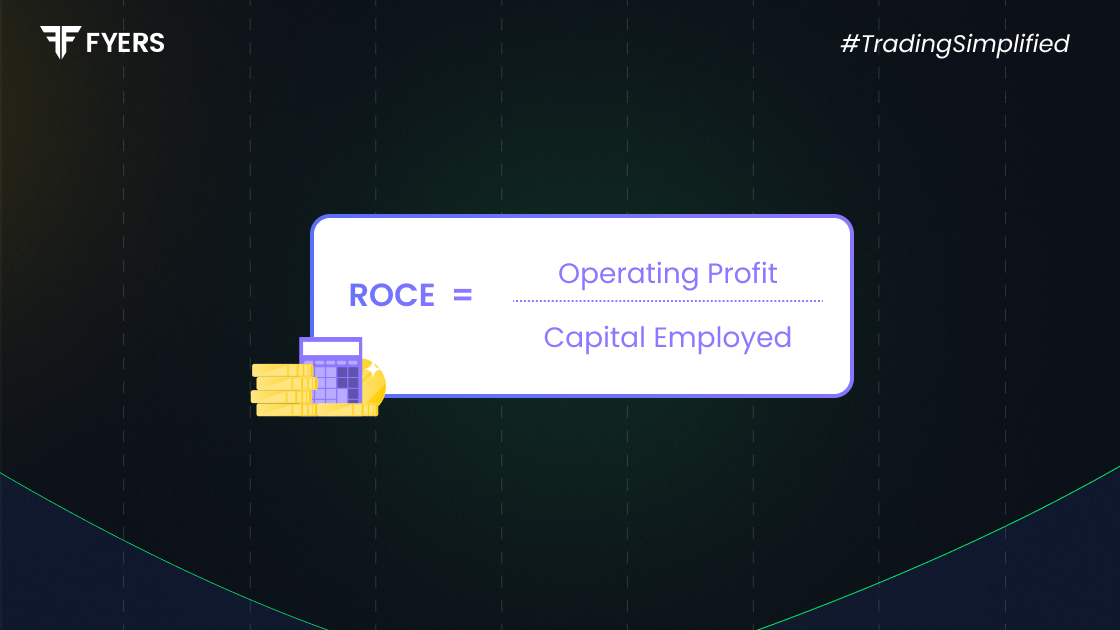

 29 Jun, 2025
29 Jun, 2025
 3 mins read
3 mins read

Understanding how efficiently a company uses its capital to generate profits is crucial for investors and financial analysts. One of the most reliable metrics to assess this is Return on Capital Employed or ROCE. It helps compare the performance of companies, especially those in capital-intensive sectors, and offers a clear view of operational efficiency.
In this blog, we’ll explore what ROCE is, how it is calculated, why it matters, and some of its limitations.
ROCE is a financial ratio that measures a company’s profitability in relation to the capital it employs. In simple terms, it tells you how much return a company generates from every rupee of capital it uses. This capital includes both equity and debt.
It is especially useful in comparing companies that require heavy capital investment, such as infrastructure, manufacturing, or energy businesses.
ROCE is considered a strong indicator of business efficiency and profitability. Here's why it’s important:
Measures Capital Efficiency: Shows how well a company is using both debt and equity to generate profits.
Comparative Tool: Helps compare companies in the same sector, even if their capital structures differ.
Investment Insight: A consistently high ROCE suggests a company is capable of generating attractive returns on invested capital.
Long-term Focus: Unlike short-term metrics, ROCE highlights long-term operational effectiveness.
Alignment with Growth: Firms with high ROCE are typically able to reinvest profits into future growth without excessive reliance on external capital.
The ROCE formula is straightforward:
| ROCE = Earnings Before Interest and Tax (EBIT) ÷ Capital Employed |
Where:
EBIT is the profit before interest and taxes.
Capital Employed = Total Assets – Current Liabilities
Or alternatively,
Capital Employed = Equity + Debt
Suppose a company has the following financials:
EBIT: ₹50 crore
Shareholder’s Equity: ₹200 crore
Total Debt: ₹100 crore
Current Liabilities: ₹50 crore
Total Assets: ₹350 crore
Let’s calculate ROCE using both approaches:
Capital Employed = Equity + Debt = ₹200 crore + ₹100 crore = ₹300 crore
ROCE = ₹50 crore ÷ ₹300 crore = 16.67%
This means the company is generating a return of 16.67% on the capital employed.
Let’s consider the the estimated ROCE of some top Indian companies:
|
Company |
EBIT (₹ crore) |
Capital Employed (₹ crore) |
ROCE (%) |
|---|---|---|---|
|
TCS |
61,000 |
97,980 |
62.3% |
|
Maruti Suzuki |
14,550 |
95,400 |
15.3% |
|
NTPC |
38,006 |
3,48,670 |
10.9% |
|
Infosys |
38,024 |
94,654 |
40.2% |
These approximate examples show how companies across sectors use their capital differently. A higher ROCE generally reflects better capital efficiency.
While ROCE is a useful metric, it’s not without its flaws:
Affected by Depreciation: Companies with older assets may show an inflated ROCE due to lower asset value.
Not Sector-Neutral: It is best used within the same industry; cross-sector comparisons may not be valid.
Ignores Cash Reserves: Excess cash lying idle can lower ROCE, even if the company is financially strong.
Doesn’t Account for Tax: As ROCE uses EBIT, it excludes taxes, which can distort real profitability.
Historical Focus: ROCE is based on past data and may not accurately reflect future performance.
Return on Capital Employed (ROCE) is a powerful financial ratio that helps investors understand how efficiently a company is using its resources. It becomes especially important when analysing capital-intensive sectors, comparing competitors, or assessing a company’s long-term profitability.
That said, like any financial ratio, ROCE should not be used in isolation. Combine it with other metrics like Return on Equity (ROE), Debt-to-Equity ratio, and free cash flow for a more complete financial analysis.
ROCE is calculated using the formula:
ROCE = EBIT / Capital Employed
Capital Employed is typically the sum of equity and debt or total assets minus current liabilities.
A ROCE above 15% is generally considered good. However, the benchmark varies by industry. Compare with peers in the same sector for better insight.
Yes, ROCE can be negative if a company has negative EBIT or is making operating losses. It indicates poor capital efficiency.
It is advisable to analyse ROCE annually. For fast-moving industries or turnaround cases, semi-annual reviews can provide timely insights.
Calculate your Net P&L after deducting all the charges like Tax, Brokerage, etc.
Find your required margin.
Calculate the average price you paid for a stock and determine your total cost.
Estimate your investment growth. Calculate potential returns on one-time investments.
Forecast your investment returns. Understand potential growth with regular contributions.